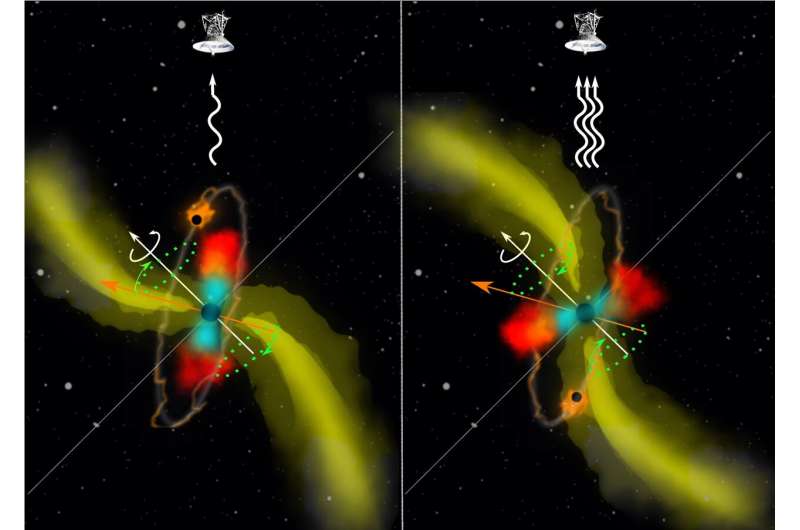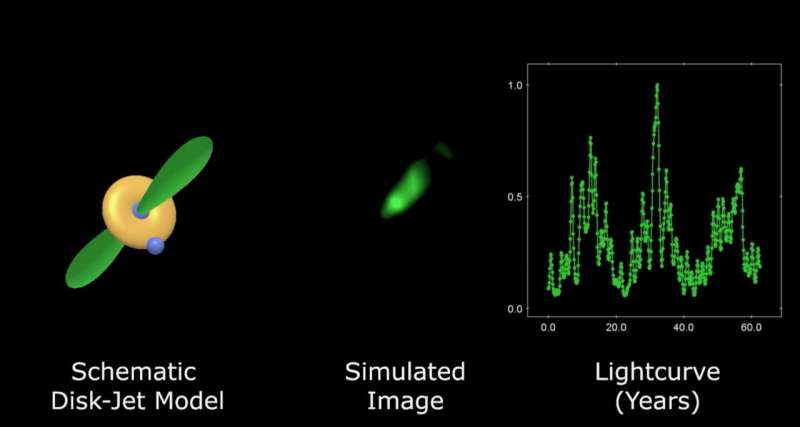This article has been reviewed according to Science X's editorial process and policies. Editors have highlighted the following attributes while ensuring the content's credibility:
fact-checked
peer-reviewed publication
trusted source
proofread
A smoking gun for supermassive binaries in active galactic nuclei

An international research team led by Silke Britzen from the Max Planck Institute for Radio Astronomy in Bonn, Germany, has investigated blazars, accreting supermassive black holes in the centers of galaxies. Blazars show up when one of the emitted jets in the active galactic nucleus is pointing directly towards the Earth.
The researchers present evidence that it is in fact the precession of the jet source, either caused by the presence of a second massive black hole close to the primary one or a warped accretion disk around a single black hole, that is responsible for the observed variability in blazars.
Blazars are the most dramatic examples in the zoo of active galactic nuclei (AGN), matter-accreting, supermassive black holes in the centers of galaxies. They show up when one of the emitted jets is pointing directly toward the Earth.
Results from decades of monitoring of blazars have always been interpreted in a way that the frequent and significant brightening of these sources, called flare activity, is associated with the ejection of jet components from the core into the jet, leading to a sudden enhanced emission.
Blazar jets are often curved and not as straight as one might expect. Meandering jet structures were thought to be connected to the component ejections from the core. Snaking jets as well as the brightening of the AGN were both expected to be of stochastic origin—depending on the feeding of the black hole. However, over the years, more detailed observational results have cast doubt on this possibly too simple causal interrelation.
A paper in The Astrophysical Journal questions this established ejection-flaring relation for the bright and strongly variable blazars. "We present evidence and discuss the possibility that it is in fact the precession of the jet source, either caused by a supermassive binary black hole at the footpoint of the jet or—less likely—by a warped accretion disk around a single black hole, that is responsible for the observed variability," says Silke Britzen from the Max Planck Institute for Radio Astronomy in Bonn, Germany, the leading author of the study.
When jets swirl around due to precession, this swirling motion naturally introduces periodic changes also in intensity, due to the effect of Doppler beaming. This has been detected in a number of AGN jets over many years.
For OJ 287—the best candidate for hosting a supermassive black hole binary—Silke Britzen and her team had established the precession origin of the strong variations in brightness and jet bending in their Rosetta-paper. Most recently, predictions from their work have been confirmed by Komossa and team.
The team now applied the same model to other blazars. For a sample of 12 prominent AGN, their results demonstrate how the variability in brightness and jet curvature, can indeed be explained by the modulating power of precession.

The authors do not question that the underlying and hard-to-tackle jet physics can also be caused by internal interactions in the jet, explained by the so-called shock-in-jet model, by instabilities in the jet beam, or by energetic magnetic reconnection. However, they propose that the appearance of these jets, is strongly modulated and altered by the jet precession. Essentially, these jets would not appear as curvy and as bright, if not enhanced by the effect of precession.
By releasing the one-to-one correlation of the brightness enhancements with the ejection of jet components, allows to explore the interplay of a dynamical system that is essentially predictable, as it can be understood in geometrical terms.
"Blazar variability in many galaxies might predominantly not be of stochastic, but of deterministic nature," continues Silke Britzen. "It is fascinating to decode the inner workings of this black hole machinery with the help of variability studies."
One of the most important implications of this study is that the jet curvature is likely a telling signature of the existence of binary black holes at the center of these galaxies. Thus, the jet is forced to meander due to the gravitational influence of a second black hole on the jet-emitting black hole. In addition, the team managed to detect traces of a smaller-amplitude nutation motion in the radio light curves as well as in the kinematics of jet components—a second-order effect and additional proof of precession.
"Physics of accretion disks and jets is rather complex but their bulk kinematics can be compared to simple gyroscopes—if you exert an external torque on an accretion disk, for instance by an orbiting secondary black hole, it will precess and nutate, and along with it the jet as well, similar to the Earth's rotation axis that is affected by the moon and the sun," adds Michal Zajaček from the Masaryk University (Brno, Czech Republic), a co-author of the study.
Radio observations achieve the highest resolution in astronomical observations by connecting radio telescopes over very large distances with Very Long Baseline Radio Interferometry (VLBI). This is the same technique that allowed the Event Horizon Telescope (EHT) collabo-ration to image the shadow of a black hole for the first time, observing the 6.5 billion solar mass black hole in the galaxy M87.
The search for these close pairs of supermassive binary black holes is ongoing since decades and resembles the effort necessary to find a needle in a haystack.
"We still lack the sufficient resolution to probe the existence of supermassive binary black holes directly. But jet precession seems to provide the best signature of these objects, whose existence is expected not only by the black hole / AGN community, but also from the gravitational wave / pulsar community who recently published evidence for the existence of a cosmic gravitational background due to the gravitational waves emitted by the mergers of massive black holes through cosmic history," concludes Silke Britzen.
More information: Silke Britzen et al, Precession-induced Variability in AGN Jets and OJ 287, The Astrophysical Journal (2023). DOI: 10.3847/1538-4357/accbbc
Journal information: Astrophysical Journal
Provided by Max Planck Society



















